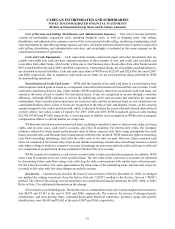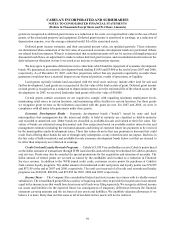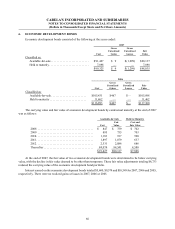Cabela's 2007 Annual Report Download - page 64
Download and view the complete annual report
Please find page 64 of the 2007 Cabela's annual report below. You can navigate through the pages in the report by either clicking on the pages listed below, or by using the keyword search tool below to find specific information within the annual report.
58
CABELA’S INCORPORATED AND SUBSIDIARIES
NOTES TO CONSOLIDATED FINANCIAL STATEMENTS
(Dollars in Thousands Except Share and Per Share Amounts)
Vendor Allowances – Vendor allowances include price allowances, volume rebates, store opening costs
reimbursements, and advertising reimbursements received from vendors under vendor contracts. Vendor merchandise
allowances are recognized as a reduction of the costs of merchandise as sold. Vendor reimbursements of costs are
recorded as a reduction to expense in the period the related cost is incurred based on actual costs incurred. Any cost
reimbursements exceeding expenses incurred are recognized as a reduction of the cost of merchandise sold. Volume
allowances may be estimated based on historical purchases and estimates of projected purchases.
Deferred Catalog Costs and Advertising – Advertising production costs are expensed as the advertising
occurs except for catalog costs which are amortized over the expected period of benefit estimated at 3 to 12 months
after mailing. Unamortized catalog costs totaled $32,569 and $34,869 at the end of 2007 and 2006, respectively.
Advertising expense, including catalog costs amortization, and website marketing paid search fees, was $207,373,
$191,533 and $170,024 for 2007, 2006 and 2005, respectively. Advertising vendor reimbursements netted in advertising
expense above totaled $7,058, $4,546 and $4,783 for 2007, 2006 and 2005, respectively.
Store Pre-opening Expenses – Non-capital costs associated with the opening of new stores is expensed as
incurred.
Property and Equipment – Property and equipment are stated at cost. Depreciation and amortization are
provided over the estimated useful lives of the assets, including assets held under capital leases, on a straight-line
basis. Leasehold improvements are amortized over the lease term or, if shorter, the useful lives of the improvements.
Assets held under capital lease agreements are amortized using the straight-line method over the shorter of the
estimated useful lives of the assets or the lease term. The costs of major improvements that extend the useful life of
an asset are capitalized. Long-lived assets are reviewed for impairment whenever events or changes in circumstances
indicate that the carrying amount of an asset may not be recoverable. Capitalized interest on projects during the
construction period totaled $4,069 and $355, for 2007 and 2006, respectively. Costs related to internally developed
software are capitalized and amortized on a straight-line basis over their estimated useful lives.
Intangible Assets – Intangible assets, recorded in other assets, include deferred financing costs, non-compete
agreements, and goodwill. At the end of 2007 and 2006, intangible assets totaled $8,123 and $3,172, net of accumulated
amortization of $4,509 and $3,847, respectively. Intangible assets, excluding goodwill, are amortized over three to
17 years. Amortization expense for these intangible assets for the next five years is estimated to approximate $744
(2008), $743 (2009), $739 (2010), $606 (2011) and $392 (2012).
On September 27, 2007, we purchased the net assets, and assumed certain liabilities, of an outdoors specialty
retailer located in Winnipeg, Manitoba, totaling $11,162. The purchase price has been allocated to tangible and
identifiable assets acquired and liabilities assumed based on their estimated fair values at the date of acquisition.
The excess of the purchase price over the fair value of the net assets acquired was recorded as goodwill of $3,505.
We recorded goodwill related to this acquisition based on expected future economic benefits as this acquisition will
serve as our platform for expansion into Canada. Results of operations for this acquisition for the last three months
of 2007 are included in our consolidated income statement.
Land Held for Sale or Development – Proceeds from the sale of land from development activities are
recognized in other revenue and the corresponding costs of land sold are recognized in other costs of revenue.
Government Economic Assistance – When we construct a new retail store or retail development, we
may receive economic assistance from local governments to fund a portion or all of our associated capital costs.
This assistance typically comes in the form of cash and/or land grants and has been typically funded by the local
government through proceeds from the sale of economic development bonds. We have historically purchased the
majority of the bonds associated with our developments. Cash grants are made available to fund land, retail store
construction, and/or development infrastructure costs. Economic development bonds are typically repaid through
sales and/or property taxes generated by the retail store and/or within a designated development area. Cash and land
























